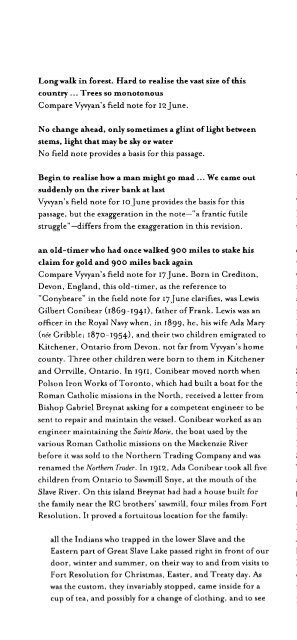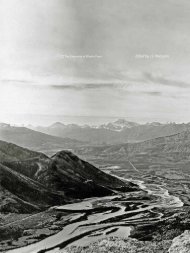C Ihe Ladies c cu. V'VVAN - History and Classics, Department of
C Ihe Ladies c cu. V'VVAN - History and Classics, Department of
C Ihe Ladies c cu. V'VVAN - History and Classics, Department of
- No tags were found...
Create successful ePaper yourself
Turn your PDF publications into a flip-book with our unique Google optimized e-Paper software.
Notes to Pages 44-45 255Long walk in forest. Hard to realise the vast size <strong>of</strong> thiscountry ... Trees so I1lOnotonousCompare Vyvyan's field note for 12June.No change ahead, only SOInetitnes a glint <strong>of</strong> light betweenstems, light that may be sky or waterNo field note provides a basis for this passage.whether Dad could mend some piece <strong>of</strong> broken equipmentin his forge <strong>and</strong>, after a while, to see whether Mother would<strong>of</strong>fer a better price for some <strong>of</strong> their furs or sell some articlesat lower costs than they would have to pay the Hudson'sBay or private traders in Resolution. By the time we had toleave Sawmill Isl<strong>and</strong> Mother had established a good reputationas a fur trader <strong>and</strong> general merchant. (Conibear)Begin to realise how a man Inight go Inad ., , We caIne outsuddenly on the river bank at lastVyvyan's field note for 10 June provides the basis for thispassage, but the exaggeration in the note-"a frantic futilestruggle"-differs from the exaggeration in this revision.an old-tiIner who had once walked 900 Iniles to stake hisclaiIn for gold <strong>and</strong> 900 Iniles back againCompare Vyvyan's field note for 17 June. Born in Crediton,Devon, Engl<strong>and</strong>, this old-timer, as the reference to"Conybeare" in the field note for 17 June clarifies, was LewisGilbert Conibear (1869-1941), father <strong>of</strong> Frank. Lewis was an<strong>of</strong>ficer in the Royal Navy when, in 1899, he, his wife Ada Mary(nee Gribble; 1870-1954), <strong>and</strong> their two children emigrated toKitchener, Ontario from Devon, not far from Vyvyan's homecounty. Three other children were born to them in Kitchener<strong>and</strong> Orrville, Ontario. In I9II, Conibear moved north whenPolson Iron Works <strong>of</strong> Toronto, which had built a boat for theRoman Catholic missions in the North, received a letter fromBishop Gabriel Breynat asking for a competent engineer to besent to repair <strong>and</strong> maintain the vessel. Conibear worked as anengineer maintaining the Sainte Marie, the boat used by thevarious Roman Catholic missions on the Mackenzie Riverbefore it was sold to the Northern Trading Company <strong>and</strong> wasrenamed the Northern Trader. In 1912, Ada Conibear took all fivechildren from Ontario to Sawmill Snye, at the mouth <strong>of</strong> theSlave River. On this isl<strong>and</strong> Breynat had had a house built forthe family near the RC brothers' sawmill, four miles from FortResolution. It proved a fortuitous location for the family:all the Indians who trapped in the lower Slave <strong>and</strong> theEastern part <strong>of</strong> Great Slave Lake passed right in front <strong>of</strong> ourdoor, winter <strong>and</strong> summer, on their way to <strong>and</strong> from visits toFort Resolution for Christmas, Easter, <strong>and</strong> Treaty day. Aswas the <strong>cu</strong>stom, they invariably stopped, came inside for a<strong>cu</strong>p <strong>of</strong> tea, <strong>and</strong> possibly for a change <strong>of</strong> clothing, <strong>and</strong> to seeThus did the Conibears become "the first independent whitefamily to settle in the Northwest Territories" (Bevington 386).The Conibears moved to Fort Smith about 1916, when theNorthern Trading Company decided to move its boat operationto Bell Rock, a few miles downstream <strong>of</strong> the settlement.The "900 miles" walked by Lewis Conibear oc<strong>cu</strong>rred inconnection with oil. not gold. According to KennethConibear (b. 1907), "the trip he is reported to have gone onwas in fact from Fort Smith to Fort Norman <strong>and</strong> some fiftymiles or so beyond that to the site <strong>of</strong> the Norman oil wells. He<strong>and</strong> my two brothers, Frank <strong>and</strong> Jack, made the trip inmidwinter, by dog team, <strong>and</strong> staked claims over the wells. That,I believe, was in 1921. My father then spent a good portion <strong>of</strong>the following summer in the Outside, trying, without success,to sell the claims."Several sIniling girls, sly-faced <strong>and</strong> slit-eyed, going hOInefroIn schoolThis refers to children at Hay River residential school. As far asthe women's route is concerned, in the 1920s, Anglicanmissions operated day schools at forts Smith, Simpson, <strong>and</strong>McPherson, as well as at Aklavik, <strong>and</strong> a boarding school at HayRiver. Roman Catholic missions operated day schools at fortsSmith, Simpson, <strong>and</strong> Good Hope, a summer day-school atWrigley, <strong>and</strong> boarding schools at Fort Resolution, Providence,<strong>and</strong> Aklavik. Both churches ran the schools with the aid <strong>of</strong>grants from the federal government's <strong>Department</strong> <strong>of</strong> IndianMfairs (Kitto, North West 62).Mixed <strong>and</strong> interesting crowdApart from the sentence beginning, "Steamer hooted ...," thislong passage is very similar to Vyvyan's field note for 17 June;however, the chapter's re-creation is accorded a greater degree<strong>of</strong> ellipSiS <strong>and</strong> more radical parataxis, which might be expectedin field notes but which cannot actually be found in hers at thispoint.
















